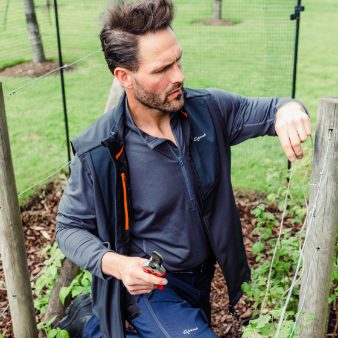The August Edit

At this point in the season, the garden goes through a gentle transitional stage. A girlfriend who came to visit described it perfectly: “By the time the Garden reaches August she ripens and becomes middle-aged and tired looking and is preparing for the next stage of life!”. As I laughed at her words, they also resonated with my own perspective and the gardens..
This year our fig tree is absolutely laden with fruit, and, providing we get some nice hot days to ripen, I’ll look forward to harvesting them, along with some Victoria plums. The dahlias have been very slow to get going here this summer, but I’m feeling confident that by mid August I’ll be picking bucket loads to fill the house, and share with family and friends.
1- Edit! Once all the abundance of spring and some of the early summer flowers have faded, looking tired and floppy, I like to do what we call “editing”. I do this by giving select perennials a good cut back to the ground. This helps to make them look tidier and offers other plants a chance to shine! Some of the plants I cut back are Geraniums that have finished flowering, (ones that are later flowering can be left) Alchemilla mollis, Stachys (lambs ears), Astrantia and Nepeta are also cut back.
2- Prune lavender. It’s easy to forget about these sun loving, woody shrubs after their purple fragrant flowers have faded. I certainly have, and after a year or two of not cutting away the faded blooms, they became too woody and too late to rescue! It’s such a quick and easy job, I use a pair of shears to trim away all the flowers, right down to their base, including an inch of leaf growth. Avoid cutting any deeper where the woody stems are, as lavender produces little or no new foliage from older stems. Doing this now can help to keep lavender bushes in a good compact shape. Some of our older lavender are starting to look quite tired and will be replaced in the autumn.
3- Tidy bearded iris leaves, this can help do away with that ugly floppy look. Keeping the leaves upright will hopefully prevent any disease and fungal spores developing too! The first thing to do is to discard any yellow or brown outer leaves by peeling them away from the rhizome like you would peel the petals off an onion. Next, trim the leaves back by half into a fan shape. All of this improves airflow to the plant and stops rainwater from sitting on the top of the leaves causing them to rot.
4-Hedge clipping. We (or should I say Tom!) can spend up to a week trimming all the yew and hornbeam hedges inside the walled garden in August. It’s quite a mammoth job for one person! But, my goodness, when it’s all been done it looks amazing. The reason for doing it now is that during spring there are a huge amount of birds nesting
5- Collect ripened seeds. During the spring and early summer, I keep a mental note (sometimes if I’m organised I will put a little tie on the plant too) to remind myself of certain plants that I would like more of. My favourites are foxgloves, nigella (love-in-the-mist) poppies, and Aquilegia (granny’s bonnet)
The reason I choose these is that they are the perfect natural fillers in the our garden; they are reliable, and bring a huge amount of satisfaction and joy! Once the chosen plant has turned brown, using a large paper bag or laying out a mat at the base, I will gently tap the dried stem to release some of the seeds into it or onto the matting. It is a case of then either saving and storing them in a paper bag in a cool dry place, or finding a new spot elsewhere in the garden. Most of the time I prefer to scatter the seeds in and around the area they were growing, letting nature do the rest!
Hoping you have a wonderful sunny August!







